A blind dog helmet, also known as a halo or bumper, can be a game-changer for visually impaired dogs, offering them a newfound sense of confidence and safety as they navigate the world. These helpful devices act as a buffer, preventing painful bumps and injuries to the head and face. This comprehensive guide will explore everything you need to know about blind dog helmets, from choosing the right one to helping your dog adjust to wearing it.
Choosing the Right Blind Dog Helmet
Selecting the appropriate blind dog helmet for your furry friend is crucial for ensuring its effectiveness and comfort. Consider the following factors:
- Size and Fit: Accurate measurements of your dog’s head circumference and snout length are essential for a proper fit. A helmet that’s too loose can easily slip off, while one that’s too tight can be uncomfortable and restrict breathing.
- Material: Look for lightweight, durable, and non-toxic materials. Common options include plastic, foam, and padded fabric. Consider your dog’s activity level and environment when choosing the material. For example, a more robust material might be necessary for a highly active dog.
- Design: Helmets come in various designs, including halos, bumpers, and full-face guards. The best design will depend on your dog’s specific needs and the severity of their vision impairment. Some helmets even offer adjustable straps and padding for a customized fit.
- Visibility: Opt for a helmet with bright colors or reflective strips to enhance your dog’s visibility, especially during walks at night or in low-light conditions.
Helping Your Dog Adjust to a Blind Dog Helmet
Introducing a blind dog helmet requires patience and positive reinforcement. Start by letting your dog sniff and explore the helmet. Then, gradually introduce the helmet for short periods, rewarding your dog with treats and praise.
- Positive Associations: Make the experience positive by associating the helmet with enjoyable activities, such as mealtime or walks.
- Gradual Introduction: Start with short wearing periods and gradually increase the duration as your dog becomes more comfortable.
- Positive Reinforcement: Use treats, praise, and gentle encouragement to reward your dog for wearing the helmet.
- Supervision: Supervise your dog closely, especially during the initial stages of adjustment, to ensure the helmet fits properly and doesn’t impede their movement.
Maintaining Your Dog’s Blind Dog Helmet
Proper maintenance is essential for ensuring the longevity and effectiveness of the helmet. Regularly inspect the helmet for any signs of wear and tear, such as cracks or loose straps. Clean the helmet according to the manufacturer’s instructions.
- Regular Inspection: Check the helmet for any damage or loose parts.
- Cleaning: Clean the helmet regularly to prevent the buildup of dirt and bacteria.
- Storage: Store the helmet in a safe place when not in use.
 Cleaning Blind Dog Helmet
Cleaning Blind Dog Helmet
Beyond the Helmet: Supporting Your Blind Dog
While a blind dog helmet offers valuable protection, it’s essential to implement additional strategies to support your visually impaired companion. Creating a safe and predictable environment, using verbal cues, and providing plenty of mental and physical stimulation are crucial for enhancing their quality of life.
Conclusion
A blind dog helmet can significantly improve the safety and well-being of a visually impaired dog. By carefully choosing the right helmet, patiently introducing it to your dog, and providing ongoing support, you can empower your furry friend to navigate their world with confidence and independence. Remember to consult with your veterinarian for personalized advice and guidance.
FAQ
- How do I measure my dog for a blind dog helmet? Measure the circumference of your dog’s head at the widest point and the length of their snout from the tip of their nose to the base of their skull.
- Can my dog sleep with a blind dog helmet on? It’s generally not recommended for dogs to sleep with a helmet on as it can be uncomfortable and potentially restrict breathing.
- How do I clean a blind dog helmet? Most helmets can be cleaned with a mild soap and water solution. Always check the manufacturer’s instructions for specific cleaning recommendations.
- What if my dog doesn’t like the helmet? Introduce the helmet gradually and use positive reinforcement to create a positive association. If your dog continues to resist, consult with a professional dog trainer or behaviorist.
- Are there alternatives to a blind dog helmet? Other assistive devices for blind dogs include harnesses with handles, and indoor safety gates.
- Where can I buy a blind dog helmet? Blind dog helmets can be purchased online, at pet supply stores, or from specialized retailers.
- How long will a blind dog helmet last? The lifespan of a helmet will depend on the quality of the material and how often it’s used. Regularly inspect the helmet for wear and tear and replace it as needed.
ILM Dog is your trusted source for expert advice on all aspects of dog care and well-being. We offer a wealth of information on dog breeds, health, training, nutrition, grooming, and much more. Whether you’re a new dog owner or a seasoned expert, ILM Dog is dedicated to providing you with the knowledge and resources you need to provide the best possible care for your canine companion. Contact us today at [email protected] or +44 20-3965-8624 for personalized guidance and support. Visit us at ILM Dog for more information.